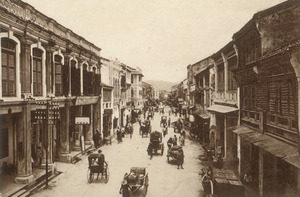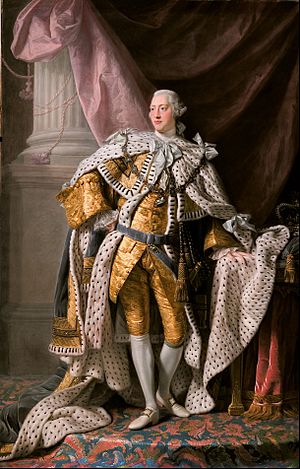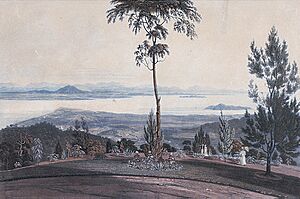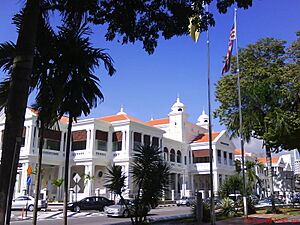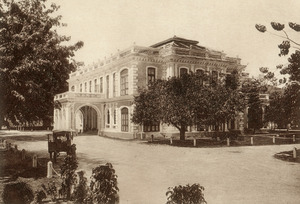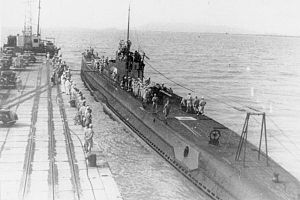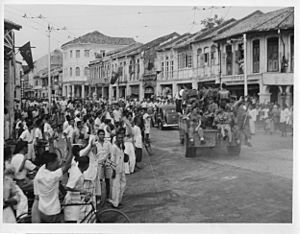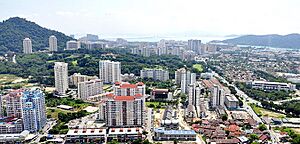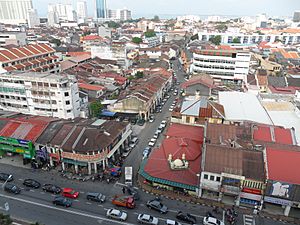History of Penang facts for kids
| Historical population | ||
|---|---|---|
| Year | Pop. | ±% |
| 1881 | 190,597 | — |
| 1891 | 231,224 | +21.3% |
| 1901 | 247,808 | +7.2% |
| 1911 | 278,003 | +12.2% |
| 1921 | 304,335 | +9.5% |
| 1931 | 359,851 | +18.2% |
| 1947 | 446,321 | +24.0% |
| 1957 | 572,100 | +28.2% |
| 1970 | 776,124 | +35.7% |
| 1980 | 900,772 | +16.1% |
| 1991 | 1,064,166 | +18.1% |
| 2000 | 1,231,209 | +15.7% |
| 2010 | 1,526,324 | +24.0% |
| 2020 | 1,740,405 | +14.0% |
| Source: | ||
Penang is one of Malaysia's most developed states. It is located on the northwest coast, along the Strait of Malacca. Unlike many other Malaysian states, Penang's modern history was shaped by British rule. This began when the British East India Company took over Penang Island from the Kedah Sultanate in 1786.
Penang became a free port, meaning no taxes on trade. It was then governed as part of the Straits Settlements, along with Singapore and Malacca. George Town, the state capital, was even the capital of the Straits Settlements for a short time (1826-1832). By the late 1800s, George Town was a major trading hub in Southeast Asia.
During World War II, the Japanese Empire took over Penang from 1941 to 1945. After the war, Penang was the first state in the Malay Peninsula to be freed by the British. The Straits Settlements ended in 1946, and Penang joined the Federation of Malaya. Even though some people in Penang wanted to stay separate, the merger happened. Malaya became independent from the British Empire in 1957 and later formed Malaysia in 1963.
In the 1960s, George Town lost its free port status. This caused economic problems and many people lost their jobs. The state government then focused on high-tech manufacturing. This helped Penang's economy recover, earning it the nickname "Silicon Valley of the East." George Town also became a popular tourist spot, especially after becoming a UNESCO World Heritage Site in 2008. Today, manufacturing and services are Penang's strongest economic areas. The state has low unemployment and a high GDP per person, second only to Kuala Lumpur in Malaysia.
Contents
Ancient Penang's History
Evidence shows that people lived in Penang a very long time ago. In Guar Kepah, Seberang Perai (the mainland part of Penang), human remains from 5,000 to 6,000 years ago were found. Along with them were seashells, pottery, and hunting tools. This suggests that nomadic people lived in Seberang Perai during the Neolithic era.
Seberang Perai was also part of the ancient Bujang Valley civilization. The Cherok Tok Kun megalith (a large stone structure) in Bukit Mertajam, found in 1845, has ancient writings. These writings show that an early Hindu-Buddhist kingdom from what is now Kedah controlled parts of Seberang Perai around the 5th or 6th century. Later, all of what is now Penang became part of the Sultanate of Kedah until the late 1700s.
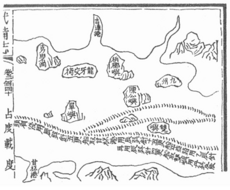
Penang Island was first written about by Chinese sailors in the 1400s. During the Ming dynasty, Emperor Yongle sent out large naval expeditions. Admiral Zheng He's fleet mapped the island, calling it Bīnláng Yù.
One of the first Englishmen to visit Penang Island was James Lancaster in 1592. He stayed for a few months, taking goods from ships he found. He was helped by the Orang Asli people from Seberang Perai.
A Portuguese historian, Emanuel Godinho de Eredia, also showed Penang Island (as Pulo Pinaom) on his 1613 map of the Malay Peninsula.
In the early 1700s, Minangkabaus from Sumatra settled on Penang Island. Led by Haji Muhammad Salleh, they started a village at Batu Uban in 1734. Later, Arabs arrived and married into the Minangkabau community. This mix of people became part of the local Malay community.
Founding of Modern Penang
Modern Penang's history truly began in the late 1700s. Before that, the Sultanate of Kedah controlled Penang. Kedah often had problems with Siam to its north. In the 1770s, the British East India Company sent Francis Light to start trade in the Malay Peninsula. Light arrived in Kedah, which was facing threats from Siam, Burma, and a local rebellion.
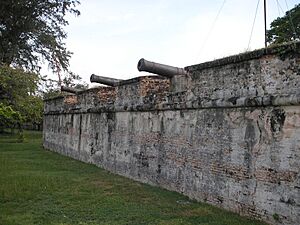
Francis Light became friends with the Sultan of Kedah, Sultan Muhammad Jiwa Zainal Adilin II. Light promised British military help. He even helped the Sultan stop a rebellion. In return, the Sultan offered Penang Island to Light. Light wrote to his bosses, saying Penang Island would be a great trading spot. He also noted its good location to watch the Dutch and French in Southeast Asia. He believed Penang could become a major trading center if it remained free from taxes.
However, nothing happened until 1786. By then, the British were fighting the American colonies, who were supported by France and the Netherlands. The British East India Company wanted Penang Island as a Royal Navy base and a trading post between China and India.
Light then negotiated with the new Sultan of Kedah, Sultan Abdullah Mukarram Shah. The British would get Penang Island. In return, Kedah would receive British military help and an annual payment of 6,000 Spanish dollars. This payment was to help Kedah with its debts to Siam. With the agreement made, Light and his group arrived on Penang Island on July 17, 1786. Fort Cornwallis was later built where Light first landed.
The area where Light landed was a swampy jungle. After clearing some land, a ceremony was held on August 11. The Union Jack (British flag) was raised for the first time. This meant the British East India Company officially owned Penang Island. The island was renamed Prince of Wales Island, after the British prince. The new settlement was named George Town, in honor of King George III. George Town became the first British settlement in Southeast Asia. It also marked the start of British rule in the Malay Peninsula.
However, Light had made promises to the Sultan without his superiors' full approval. When Light couldn't deliver British military protection against Siam, the Kedah Sultan tried to take back Prince of Wales Island in 1791. The Sultan's forces, helped by pirates, gathered in Seberang Perai. Luckily for Light, his forces on the island got help from Calcutta. After failing to make the Sultan stop, the British attacked at night. They destroyed Kedah's military bases in Perai and defeated the Sultan's army and the pirates.
In 1800, the first British leader of Prince of Wales Island, Sir George Alexander William Leith, gained a strip of land in Seberang Perai from the new Sultan of Kedah. This new agreement replaced Light's earlier one. It gave the British permanent control over both Prince of Wales Island and the new mainland area, which was named Province Wellesley.
This new land included a five-kilometer coastline south of the Perai River. The river then became the border between Province Wellesley and Kedah. At the time, Province Wellesley was mostly forest with only about 5,000 people. The agreement gave Prince of Wales Island full control of its harbor. It also secured the mainland coast, which was known for pirates. The treaty allowed food and goods to flow freely from Kedah to Penang. For Kedah, it provided protection from sea attacks. In return, the annual payment to the Kedah Sultan increased to 10,000 Spanish dollars. Even today, the Malaysian federal government still pays Kedah RM10,000 each year as a symbolic gesture.

Province Wellesley slowly grew to its current size by 1874. This happened when the Pangkor Treaty was signed between the British and the Sultanate of Perak. Province Wellesley gained the town of Sungai Acheh from Perak.
Francis Light died from malaria in 1794 and was buried in the Old Protestant Cemetery in George Town. He is still honored as the founder of Penang.
Early Growth and Trade
Francis Light made George Town a free port. This meant merchants did not have to pay taxes on their goods. This was done to attract traders away from Dutch ports. As a result, the number of ships arriving grew quickly, from 85 in 1786 to 3,569 in 1802. George Town's population also reached 10,000 by 1792. People came from many parts of Asia. In 1801, the British leader, Sir George Alexander William Leith, noted that "so many different people are assembled together or so great a variety of languages spoken" in such a small area. For example, in 1787, Light appointed Koh Lay Huan as the first Chinese leader (Kapitan Cina). Koh arrived with many Chinese and Malay people to help develop the island. A committee was also set up in George Town in 1800, making it the first local government in British Malaya.
Prince of Wales Island and Province Wellesley were managed under the Bengal Presidency until 1805. Then, Penang became a separate Presidency, like Madras and Bombay. By this time, Penang also served as a place to send prisoners. In 1796, 700 Indian prisoners were sent from the Andaman Islands. This practice continued through the 1800s. These prisoners provided labor for building roads, drains, and public buildings.
In 1807, a special document allowed for the creation of a Supreme Court and a police force in Penang. The Supreme Court of Penang opened at Fort Cornwallis in George Town in 1808. Edmond Stanley was its first judge. Over the next few decades, Penang's legal and police systems were used in the Straits Settlements. They were later copied throughout British Malaya. So, Penang is where Malaysia's current court system and police force began.
In the early 1800s, Penang became a center for spice production and trade in Southeast Asia. Pepper farming started soon after George Town was founded in 1786. The production of spices, like nutmeg and clove, grew. The busy spice trade led to many spice farms opening across Penang. Exporting spices through the Port of Penang helped the British East India Company pay for Penang's administration. These farms also helped villages like Air Itam and Balik Pulau on the island, and Bukit Mertajam in Province Wellesley, grow. Malay people escaping the Siamese invasion of Kedah and Chinese immigrants were the main workers on these farms. Other areas, like Bayan Lepas on the island and Kepala Batas in Province Wellesley, were founded as rice farms.
Straits Settlements Era
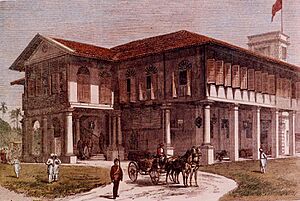
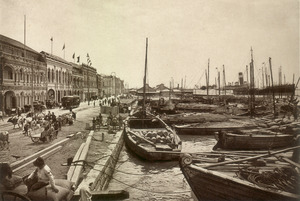
In 1826, the British East India Company combined Penang, Singapore (taken from Johor in 1819), and Malacca (taken from the Netherlands in 1824) into one group called the Straits Settlements. George Town became the main administrative and legal capital. However, Singapore's location was better for trade, between the Malacca Strait and the South China Sea. So, the Port of Singapore quickly became more important than the Port of Penang. Because of this, Singapore replaced George Town as the capital of the Straits Settlements in 1832.
Even so, George Town remained important as a British trading hub. It sent goods to large shipping lines that bypassed other ports. In the late 1800s, a tin mining boom in nearby Sultanate of Perak and Siam brought more wealth to Penang. Tin from the Kinta Valley and southern Siam was sent to George Town to be processed. Then, it was exported through the Port of Penang to Europe and America. The Port of Penang became a major tin-exporting port in British Malaya, competing with Singapore. The opening of the Suez Canal in 1869 and the use of steamships made the Port of Penang even more important. By the end of the 1800s, George Town also became a leading financial center in British Malaya. Many trading companies and international banks, like Standard Chartered and HSBC, opened offices there.
By then, Penang was home to many different ethnic and religious groups. Besides the large Chinese, Malay, Indian, Peranakan, Eurasian, and Siamese communities, there were also smaller groups. These included Burmese, British, Javanese, Japanese, Sinhalese, Jewish, German, and Armenian people.
Each ethnic group often focused on certain jobs. Europeans held professional roles and managed trading firms. Peranakans and Eurasians often worked in the new civil service as lawyers or clerks. Some new Chinese immigrants worked as laborers or farmers. However, many later started businesses in trade and real estate. Certain Chinese groups, like the Cantonese and Hakka, were skilled workers like artisans and carpenters. Indians, who first came as prisoners for public works, also started competing with the Chinese in trade and shipping. Malays mainly worked in farming and fishing. Other groups, like Jews and Armenians, focused on trade. The Armenians were known for building the Eastern & Oriental Hotel.
The rapid growth in population led to social problems, such as poor sanitation and rising crime. The increase in Chinese immigrants led to the formation of rival secret societies. Fights between these groups worsened. When British authorities tried to stop them in 1857, the Chinese groups also fought against the police. This led to the Penang Riots of 1867 in George Town. The Kean Teik Tong and Red Flag groups fought against the Ghee Hin Kongsi and White Flag. The unrest lasted 10 days before the authorities, helped by European residents and help from Singapore, stopped it.
In the same year, the Straits Settlements became a British crown colony. This meant Penang, Singapore, and Malacca were directly controlled by the Colonial Office in London. Direct British rule led to better law enforcement. Penang's police force grew, and the secret societies that had caused problems in George Town were slowly outlawed.
Meanwhile, in Province Wellesley, new railway lines were built. The first was the Bukit Mertajam-Perai line in 1899. The town of Butterworth was also established in the mid-1800s as a transport hub. In 1894, the first ferry service between George Town and Butterworth started. This service later became the Rapid Ferry we know today.
With better education and living standards, Penang gained more press freedom. Its Asian residents also became more involved in local government. Penang's representatives in the Straits Settlements Legislative Council were known for challenging policies made by the British in Singapore, especially if they hurt Penang's interests.
George Town was seen as a place that welcomed new ideas. It attracted famous English writers, Asian thinkers, and reformers. For example, the Chinese revolutionary leader, Sun Yat-sen, moved his Southeast Asian base from Singapore to George Town. He continued to organize and raise money for the Chinese revolution against the Qing dynasty. These efforts led to the important 1910 Penang conference. This conference helped pave the way for the successful Wuchang uprising that overthrew the Chinese imperial government.
World Wars Impact
World War I
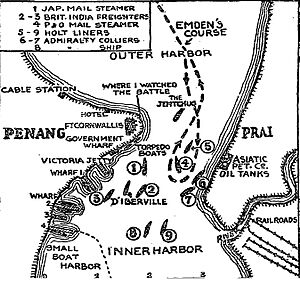
On October 28, 1914, the Battle of Penang took place. A German warship, SMS Emden, secretly entered George Town. It sank the Russian warship, Zhemchug. A French destroyer, Mousquet, chased the German ship but was also sunk. 147 French and Russian sailors died. Local Malay fishermen rescued the survivors.
Other than this naval battle, Penang and the Straits Settlements were mostly unaffected by World War I.
World War II
World War II, however, brought huge changes to Penang. The quick British retreat and the harsh treatment of Penang's Chinese residents greatly damaged British prestige among the locals.
From December 9 to 18, 1941, Japanese warplanes bombed George Town. They destroyed British and Australian air force planes based at RAF Butterworth and Bayan Lepas Aerodrome (now Penang International Airport). About 600 civilians were killed and 1,100 were injured by the Japanese bombing.
Even though the British Army had called Penang Island a fortress, Lieutenant-General Arthur Percival ordered a withdrawal. The British Army abandoned the Batu Maung Fort. They also secretly evacuated Penang's European population, leaving the Asian people to face the Japanese. Many agree that this withdrawal and secret evacuation made the British seem less powerful.
Penang fell to the Imperial Japanese Army on December 19, 1941. This marked the start of the Japanese occupation. Penang Island was renamed Tojo-to, after the Japanese Prime Minister, Hideki Tojo. George Town's harbor became a major submarine base for the Axis powers.
The Japanese treated different ethnic groups differently. Chinese residents suffered the most brutal treatment. The Japanese army killed thousands of Chinese as part of a campaign to remove anti-Japanese people.
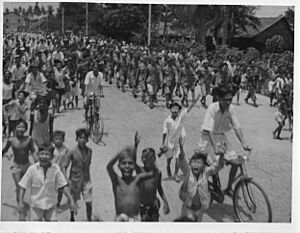
Penang's residents also faced economic hardship during the Japanese occupation. There was very high inflation due to too much Japanese money being printed. There was also a severe shortage of food and raw materials. This was because of Japanese wartime rationing and an Allied blockade of Japanese ships. Families had to eat secondary crops like sweet potatoes and tapioca to survive. Starting in 1942, Japanese lessons were compulsory in all schools. Japanese became the official language. Daily life changed greatly. People had to bow to Japanese soldiers and sing the Japanese national anthem. Streets and shops were renamed in Japanese.
Between 1944 and 1945, British and American bomber planes from India repeatedly bombed George Town. They aimed to destroy naval and administrative buildings. The destruction of the Penang Secretariat building meant many British and Japanese records about Penang Island were lost. This made it hard to write a full history of Penang after the war. The Penang Strait was also mined to stop Japanese shipping.
After the Japanese surrender on August 15, 1945, a Japanese newspaper in Penang announced the surrender. A British Royal Navy fleet accepted the surrender of the Japanese forces in Penang on September 2, 1945. A British Royal Marines group recaptured Penang Island the next day. This made George Town the first city in Malaya to be freed at the end of the war.
Post-War Changes
Penang was under military rule until 1946. The British wanted to restore order because a Communist uprising was starting. The British also ended the Straits Settlements in April 1946. Penang and Malacca then joined the Federated Malay States and Unfederated Malay States to form the Malayan Union. Singapore remained under British rule. The Malayan Union was replaced by the Federation of Malaya in 1948. It became clear that Malaya would soon gain independence.
However, some people in Penang were worried about joining the larger Malay federation. They had concerns about economic issues and the rights of non-Malays. They worried about new trade rules from the central government in Kuala Lumpur and new taxes on exports. So, the Penang Secession Committee was formed in 1948. They wanted Penang to stay separate from Malaya. They hoped Penang could either remain linked to the British Empire or join Singapore. This movement was led by D.A. Mackay, chairman of the Penang Chamber of Commerce. It included various business and ethnic associations.
In the end, the Penang Secession Committee did not achieve its goals. A motion to separate, brought up in the Penang Settlement Council in 1949, was rejected by British officials. Another request sent to London in 1951 was also denied. While some British and American observers supported the idea, the British administrators did not want to risk their plans for a united, independent Malaya. The British government also eased fears by promising to keep George Town a free port. They also brought back local elections for the city in 1951.
On January 1, 1957, Queen Elizabeth II granted George Town, the capital of Penang, city status. It became the first city in the Federation of Malaya, and later, Malaysia. George Town was the only city in Malaysia (besides Singapore for a short time) until 1972, when Kuala Lumpur also became a city.
Penang, as part of the Federation of Malaya, gained independence from the British Empire on August 31, 1957. It then became a member state of Malaysia in 1963.
Post-Independence Era
1957–1969: Early Challenges
After Malaya gained independence, Penang's political situation was complex. The new Penang state government was controlled by the Alliance coalition. This was the same group that ruled the federal government. Wong Pow Nee of the Malaysian Chinese Association (MCA) became Penang's first Chief Minister. He held this position until 1969. However, the Labour Party, an opposition party, took control of the George Town City Council. Penang voters often chose the Alliance for the state government but the Labour Party for the city council.
At that time, the George Town City Council was the only fully elected local government in Malaya. It was also the richest, with twice the income of the Penang state government by 1965. This financial independence allowed the city council to fund social welfare projects in George Town. Meanwhile, the Penang state government tried to boost manufacturing by opening industrial areas in Seberang Perai, like in Perai and Mak Mandin. Due to different political views, conflicts often arose between the state government and the city council over policies and money.
As promised by the British, George Town's free port status remained after independence. However, the fears of the secessionists eventually came true. In 1969, the Malaysian federal government suddenly removed George Town's free port status. As a result, 16.4% of Penang's workers lost their jobs. The Port of Penang's trade volume dropped sharply, badly affecting George Town's service industry. In the long run, this marked the beginning of George Town's slow decline, which only recently started to reverse.
The loss of free port status, along with a difficult strike by Penang's unions in 1967, caused people to lose trust in the Alliance party. In the 1969 State Elections, Gerakan, then an opposition party, won power in Penang. They replaced the Alliance. The party's founder, Lim Chong Eu, became the new Chief Minister. However, the unrest in Kuala Lumpur after the 1969 General Elections led to martial law across the country. The Penang state government's duties were taken over by a national council until 1971.
1970–1990: Economic Revival and Development
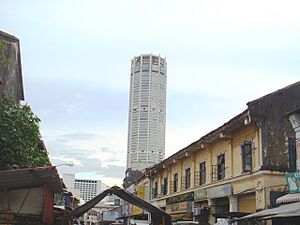
In 1973, Gerakan joined Barisan Nasional, the ruling coalition. This brought the Penang state government back under the control of the main ruling party.
To boost Penang's economy, Lim Chong Eu created the Bayan Lepas Free Industrial Zone. He invited foreign companies to invest there. Major electronics and engineering firms, like Motorola, Bosch, Hewlett-Packard, and Hitachi, set up factories in Bayan Lepas. This area was once a rice-growing region. With cheap labor, the Bayan Lepas Free Industrial Zone became a major electronics manufacturing hub in Asia. It was called the "Silicon Valley of the East." This greatly helped Penang recover from its economic problems and become a strong economic power in Malaysia. Today, manufacturing is still one of Penang's two largest economic sectors. It contributed 47.4% of Penang's GDP in 2015.
During Lim's time, several big construction projects were finished. The Penang Bridge, then the longest bridge in Southeast Asia, was completed in 1985. It provided the first road link between Penang Island and the Malay Peninsula. More debated was the 250-meter-tall Komtar in George Town. It is still the tallest skyscraper in Penang. Launched in 1974, Komtar was meant to reverse George Town's decline. However, hundreds of old shops, schools, and temples were torn down for the project. Instead of helping, Komtar itself became less useful by the early 2000s.
Meanwhile, in 1974, the Port of Penang moved from George Town to Butterworth, across the Penang Strait. This allowed larger container ships to dock. By then, sea traffic through Penang had greatly reduced since George Town lost its free port status. More trade was going to Port Klang near Kuala Lumpur.
Throughout the 1970s and 80s, the Malaysian federal government focused on developing Kuala Lumpur and Port Klang. They controlled investments in transport, education, and health. Kuala Lumpur soon became Malaysia's largest city and financial center, surpassing George Town. Port Klang quickly became the country's busiest seaport. As a result, Penang began to lose many talented young people who moved away for better job opportunities.
In 1974, the George Town City Council merged with the Penang Island Rural District Council to form the Penang Island Municipal Council. The five local councils in Seberang Perai, including Butterworth and Bukit Mertajam, merged into the Seberang Perai Municipal Council. Local elections, which had been stopped since 1965, no longer happened. Municipal councilors were appointed by the Penang state government. The merger of local governments on Penang Island also led to a long debate about George Town's city status.
In the 1990 State Elections, Lim Chong Eu lost his seat to Lim Kit Siang of the Democratic Action Party (DAP). This led to Lim Chong Eu's retirement. Although Barisan Nasional remained in power, Koh Tsu Koon became the new Chief Minister of Penang.
1991–2008: Challenges and Change
Koh Tsu Koon's time as Chief Minister saw problems with development, pollution, and a general decline in Penang. Political disagreements made development difficult. Growing unhappiness from Penang's non-governmental organizations (NGOs) and residents over the state's decline eventually led to a big political change.
In the early 1990s, plans to develop Penang Hill were made by the Penang state government. This caused a lot of opposition from civil groups who worried about environmental damage to the forested hill. The plan was eventually stopped. Meanwhile, the Rent Control Act, which protected low-income residents in George Town from unfair rent increases, was removed by 2001. This caused many residents and small businesses to move out because they couldn't afford the higher rents. Some developers started tearing down old heritage buildings for new projects, while others fell into disrepair. Concerned about losing George Town's historic buildings, NGOs in the city began to gather public support for their preservation.
By the early 2000s, Penang's economic growth slowed down. The state had the lowest growth rate for household income among Malaysian states. The loss of talented people over decades also hurt Penang. For example, while Kuala Lumpur received big projects like the Petronas Towers and the Kuala Lumpur International Airport, Penang faced a shortage of skilled engineers and architects. Professionals continued to move to the Greater Kuala Lumpur area. Also, a lack of clear urban planning and poor traffic management meant little was done to ease worsening traffic jams in Penang. Even the state's reputation for cleanliness suffered, with reports of coastal pollution and dirty streets making headlines. As early as 1996, the then Malaysian Prime Minister, Mahathir Mohamad, even called Penang a "garbage state."
Widespread unhappiness over Penang's decline led to a media campaign in 2004 to restore Penang's former glory. It is believed that public anger over the neglect of the city, once known as the "Pearl of the Orient," combined with Penang's active political scene, contributed to the defeat of Barisan Nasional in the 2008 State Election. The opposition group, Pakatan Rakyat, led by the DAP, took over the Penang state government. Lim Guan Eng succeeded Koh as the Chief Minister.
In late 2004, Penang was hit by the massive Indian Ocean tsunami. Out of 68 deaths in Malaysia, 52 were in Penang. Northern coastal areas, like Batu Ferringhi and Gurney Drive in George Town, were among the worst-hit places. After the tsunami, a network of sirens was installed across Penang. This is part of a national tsunami warning system to alert people to future disasters.
2008 Onwards: New Beginnings
The new Penang state government, led by Pakatan Rakyat, took office in 2008. This led to many positive policy changes. In that year, the George Town city center, along with Malacca, was named a UNESCO World Heritage Site. This was thanks to years of conservation efforts by the city's NGOs. The new state government then focused on improving hygiene, cleanliness, and making areas more pedestrian-friendly. They also promoted public transport and celebrated the city's diverse cultures. By 2010, George Town was ranked the most livable city in Malaysia. It was also eighth in Asia. In 2017, the city was ranked the second cleanest in Malaysia, after Ipoh.
Economically, the current state government has focused on attracting foreign direct investments. They also aim to move Penang up the economic value chain and fight corruption. In 2010, Penang received the highest amount of capital investments in Malaysia, attracting RM12.2 billion. This was 26% of the nation's total investments. Penang's amazing economic recovery since 2008 was called Malaysia's "biggest economic success" by Bloomberg. This happened even though the Malaysian federal government focused on other states. The Penang state government also reduced Penang's public debt by 95%. It went from RM630 million in 2008 to RM30 million by late 2011. In 2016, George Town was rated the most attractive place for commercial property investment in Malaysia by Knight Frank, even surpassing Kuala Lumpur.
In 2015, the Malaysian federal government upgraded the Penang Island Municipal Council to the current Penang Island City Council. This expanded George Town's area to include the entire Penang Island and five surrounding islets. This also made George Town the only Malaysian city to have been given city status twice.
The Second Penang Bridge, currently the longest bridge in Southeast Asia, opened in 2013. It is 24 kilometers long. It provides a second road link between Penang Island and Seberang Perai. It has also encouraged the development of new industrial areas like Batu Kawan.
See also
- History of George Town
- Straits Settlements
- List of governors of Penang


